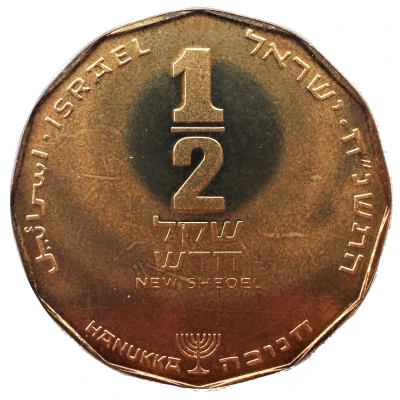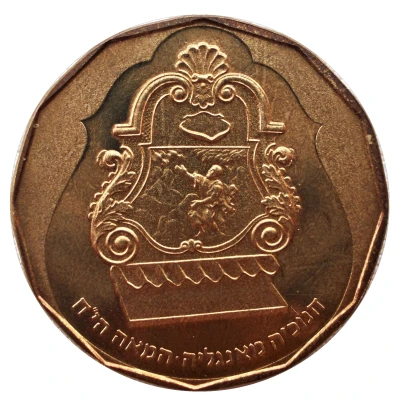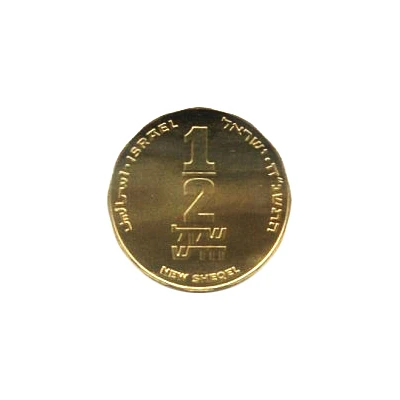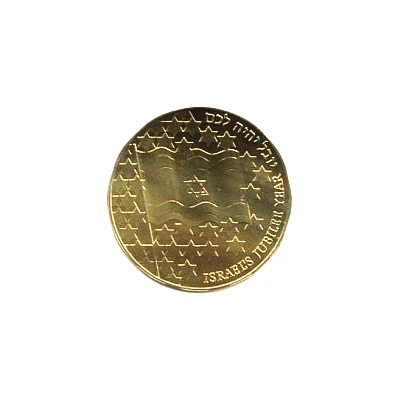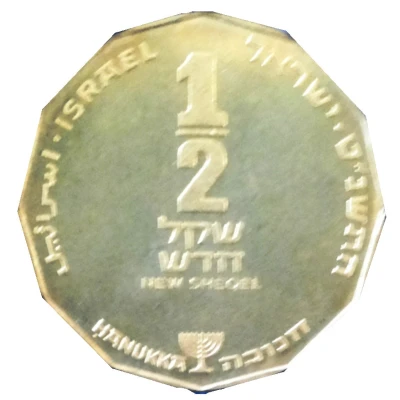
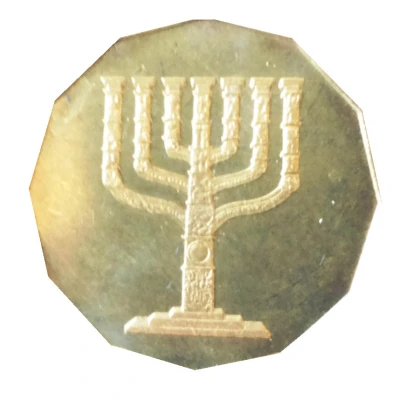

½ New Sheqel Hanukkah Mint Set - The Menorah - End of the 50th Anniversary Year of Israel
5759 (1998) year| Bronze | 6.5 g | 26 mm |
| Issuer | Israel |
|---|---|
| Period | State of Israel (1948-date) |
| Type | Non-circulating coin |
| Year | 5759 (1998) |
| Calendar | Hebrew |
| Value | ½ New Sheqel ½ ILS = USD 0.13 |
| Currency | New Shekel (1986-date) |
| Composition | Bronze |
| Weight | 6.5 g |
| Diameter | 26 mm |
| Shape | Dodecagonal (12-sided) |
| Technique | Milled |
| Orientation | Medal alignment ↑↑ |
| Updated | 2024-10-05 |
| Numista | N#81361 |
|---|---|
| Rarity index | 83% |
Reverse
The menorah standing in the Knesset courtyard
Edge
Plain
Comment
The Hanukka Mint Set 1998/5759 issued by the Bank of Israel includes the circulation coins bearing the issue year of 5759 as well as a tiny Hanukkah lamp. The reverse of the coins bears a tiny Star of David. In addition, the set includes the special Half Sheqel coin, bearing the menorah standing in the Knesset courtyard – the emblem of the State of Israel – marking the end of the 50th Anniversary year of Israel.The beautiful Presentation Folder's design is inspired by an exhibition held at the Israel Museum which traced the evolution of this ancient symbol.
The menorah (Seven-branched candelabrum) emanated light and sanctity in the Temple ritual. Already, by the Second Temple period, it embodied additional messages: in Zechariah's vision from the return from exile, the menorah represented renewal and redemption, and on the coins from Mattathias Antigonus, the last of the Hasmonean kings, it expressed a nationalism challenging Roman rule.
After Romans destroyed the Second Temple in 70 CE, the golden menorah was taken, along with the temple treasury, to Rome. It is depicted in the center of the relief on the Arch of Titus which portrays the triumphal procession over Judea.
When the State of Israel was established, the menorah was chosen as the State Emblem, to reinforce the "return to the glory of antiquity".
The initial significance of the menorah – illumination – was the first of many layers of meaning to be added over the generations, thereby turning the menorah into a widely evocative symbol. It expressed the yearning for redemption and return from exile. The menorah allowed the Jew to identify himself amidst the greater world. The symbol of the menorah became a good luck charm which provided protection and good fortune.
With the elevation of the menorah to a national Zionist symbol, and its choice as the national emblem, it has become a widespread motif seen in daily Israeli life. It seems natural to place it on artistic works as well as everyday articles.
Interesting fact
One interesting fact about this coin is that it features a unique design that represents the Menorah, a symbol of the Jewish faith and a prominent part of the Hanukkah tradition. The coin's design showcases the seven-branched candelabrum with a lit candle in the center, surrounded by intricate details and patterns. This design not only adds aesthetic value to the coin but also serves as a representation of Israel's rich cultural heritage and history.
Price
| Date | Mintage | VG | F | VF | XF | AU | UNC |
|---|---|---|---|---|---|---|---|
| 5759 (1998) | 8000 | - | - | - | - | - | - |
Values in the table are based on evaluations by sales realized on Internet platforms. They serve as an indication only for ½ New Sheqel (Hanukkah Mint Set - The Menorah - End of the 50th Anniversary Year of Israel) 5759 (1998) coin.
